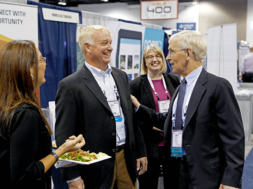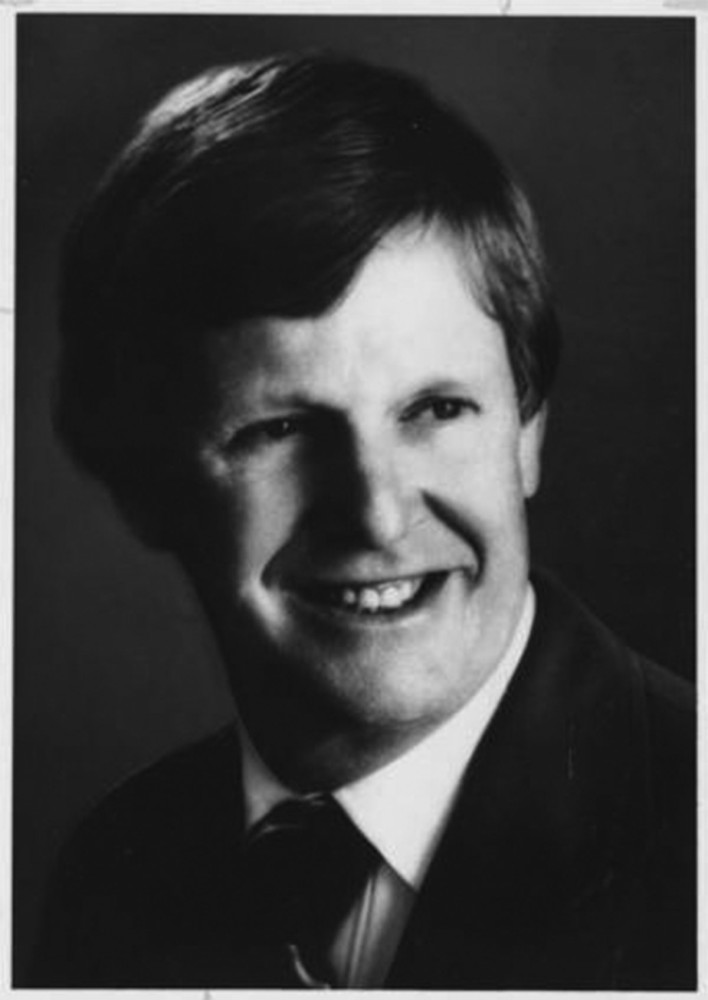
On May 18, 2015, Coleman Furr passed away. In recognition of his nearly 50 years of dedication to higher education we celebrate Coleman’s life. The following are comments from colleagues and friends.
Innovator, leader, commissioner, chairman, founder, president, dreamer, teacher, awardee, creator, pioneer, contributor, and genius (do you know any other members of Mensa?), these are some of the words used to describe Coleman Furr through the years.
Cole, as he was known to us friends, was introduced to the computer by IBM; and it became his life’s work. He used the skills he learned in helping the United States Army during WW II by guiding convoys on a mountainous segment of the Burma Road with the use of a computer. After the war he returned to Nebraska and worked as the manager of data processing with the Furr Company, a family-owned grocery business.
The government of Puerto Rico called on him to improve their food distribution system through the use of computers. It was there that he recognized the challenges of finding and hiring qualified data processing personnel. That discovery was to change his life’s work.
Moving to San Diego, Cole worked for FedMart, the forerunner of Costco. In his responsibilities there, his understanding of the need for qualified personnel was heightened. So, he and his wife, Lois, founded the Automation Institute of San Diego in 1963, which became Coleman College in 1969, accredited by the Accrediting Commission of the Association of Independent Colleges and Schools. In 1972 the College became a non-profit educational institution. By 1982 the College was offering both baccalaureate and Masters Degrees.
When Cole and Lois opened the school, it had one teacher and 14 students. It was located in a small building in downtown San Diego. When he passed away in May 2015, the College occupied 5.5 acres of some of the most expensive real estate in San Diego County.
As an example of his innovative spirit, when he moved the College, he chose an abandoned bowling alley, which more than served his purposes with a large parking lot, which was always a problem downtown, located on a major transportation artery, with dining facilities for the students and large open classrooms. Rather than create a library with its own specific space, he scattered the volumes throughout the facility making them easily accessible to the students.
One feature of the new location was a large amphitheater capable of housing all or most of the students at one time. The wall of this room had a giant picture of the Earth as seen from outer space.
It would not be unusual to find Dr. Furr rehearsing one of his many lectures in this room, which became a meaningful part of the curriculum offerings.
Cole is credited with creating the “inverted curriculum,” which provided students with specific job-related skills and techniques from the first day of class. This insured that whenever students left the institution, either at graduation or before, they would possess employable skills. This concept remains unique today, particularly in our public institutions.
While his institution was growing and gaining a national reputation, Cole found time to contribute to the sector by running for office with the Association of Independent Colleges and Schools. He first served on the Accrediting Commission of this group (chair in 1977) and later was elected to a position as chair on the AICS board, 1988-90. During his service on the Commission, he became concerned with the apparent lack of consistency in the agency’s financial review process. He was responsible for the creation of an official Financial Review Committee, which is still in use today.
He was a member of the AICS board that hired me to be its Executive Vice President in 1976. As a part of my orientation, shortly after I assumed the position, I toured the country visiting our member institutions all across the country. Cole’s unique school was one that was included on the tour.
During dinner, after visiting his impressive campus, Cole said, “You know, we do not need two national associations, AICS and the National Association of Trade and Technical Schools (NATTS). They are both about the same size with a Washington office, a staff, a convention, publications, and so forth for each. We ought to merge them.” Having just taken the job, I am not sure I was terribly excited about the idea, which might be the end of my AICS career.
But as it turned out, by the time Cole ran for the AICS board chair in 1988, I had left the association’s staff after serving for eight years, to become president of ESS College of Business in Dallas, and I also ran for the AICS board elected to follow Cole as chairman in 1990.
His term of office coincided with the reauthorization of the Higher Education Act. We opposed several elements of the proposed, HEA, which, if passed would have had a significant negative impact on the sector. We had to rally the troops and fight the proposals. To bring this message to the AICS members, Cole took the stage at the annual meeting to deliver this message dressed in a military uniform, somewhat like the George C. Scott portrayal of General Patton. It was a most effective and unforgettable moment in our history.
Later that year, with help and encouragement from NATTS Chairman Roger Hess, Cole led the two organizations to form a Consolidation Study Committee to address the possibility of merging the two organizations. As a result of their work, the groups agreed to the idea and set a date for the merger, Aug. 1, 1991. The concept that Cole described to me in 1976 had actually come to pass 15 years later. It was his vision and leadership that made it possible for the creation of the Career College Association, which has become the Association of Private Sector Colleges and Universities.
Would it have happened without his vision? We will never know the answer to that, however, we are thankful he had the vision and stuck with it.
-Stephen B. Friedheim, Strategic Coach, Education Systems & Solutions
Few will remember how important Coleman Furr was to the private career college sector. The difficult times we face today echo back to the late 1980s and early 1990s when bashing proprietary schools seem to infect newspapers and political diatribes. Maxine Waters and others made a concerted effort to destroy entrepreneurial educational programs in our country. Cole Furr as a leader in AICS worked together with his colleagues from NATTS to bring together the two most important trade associations. Most agreed that Cole’s leadership allowed the merger of the two associations, which were able to pull resources to fight the opponents of the sector. Cole’s out of the box thinking, organizational skills, and effective leadership will be sorely missed.
-Dr. Arthur Keiser, Chancellor and CEO, Keiser University
I first became aware of Coleman Furr, and his wife and partner Lois, in the mid 1960s. Sullivan Business College (now Sullivan University) was founded in 1962 and one of our new programs was what we called “IBM Training.” I learned several years later that there was another school in San Diego, CA that was started in 1963 that focused on IBM training getting a national reputation for IBM training and that was Coleman. I am not sure exactly when I met Cole but I think it was out of a curiously to learn more about this innovative and creative man and his vision for Data Processing education. We soon connected and that friendship remained for nearly 50 years until his death.
A little known fact is that Cole was invited, along with a small group of school men, to attend the very first meeting of what was called the “Idea Club” in Los Angeles in 1974. That first group meeting grew to what in 2015 is now called “The Private Education Research Council (PERC).” PERC is now in its 41st year of providing a forum for innovative idea sharing which has allowed PERC member schools to prosper and grow. Cole was a distinguished Emeritus member of PERC until his death. Although retired he recently attended a PERC meeting in 2012 in Hawaii where he was recognized by the PERC membership for his nearly 50 years of service and leadership in career education. It was a joyous occasion for me of remembering the challenges we faced together in the early 1970s.
I was fortunate to serve with Coleman on the AICS Accrediting Commission in the early 1970s. I was elected to serve as chairman of the Commission in 1976 and Coleman followed me as chair of the Commission in 1977. We both served together over six years on the Commission. Coleman was chosen for the associations (AICS) “Distinguished Service Award” in 1975, recognizing his service to the field.
A side note: Many in the school business are not aware that AICS was the acronym for “Association of Independent Colleges and Schools” which had become the new name for UBSA which was the acronym for the “United Business Schools Association.” The name change occurred in 1972. AICS also changed the name of the “Accrediting Commission for Business Schools (ACBS)” to “AICS – Accrediting Commission” at the same time. Cole was an active leader in the Association and Accrediting Commission during those years in the early and mid-1970s.
I think I need to share more about the man and his innovative mind. Cole wrote his doctoral dissertation on “Computer Managed Instruction.” I am fortunate to have a copy of that brilliant document in my personal library. As always – he was to the point, ahead of the curve in higher education – and a nationally recognized leader in computer education. Coleman College was selected by a major computer magazine as the “Best Computer Education institution in the United States in the early 1970s.” No one in computer education – from career school to major university – challenged that designation.
He also had the most interesting college campus one could imagine. He bought what I remember as a 64 lane bowling alley in the San Diego suburbs and had the first open landscape classrooms set up I had ever seen. The multiple major IBM computers used in education were placed in the raised central corridor with the classrooms and labs separated by dividers and open space on either side. He had several enclosed lecture halls in this huge facility where he was one of the first educators to capture all of his lectures on video so students could watch it later if they had to miss a class.
His ideas shared at PERC over the years were always captivating and gave many of us a head start in growing our own schools computer science programs.
He shared willingly, and his innovations shared gave all of us in PERC a head start in the growing and challenging computer education field.
Coleman Furr…A deep thinker, innovative educator, and loyal friend. You will be missed.
-Dr. Al Sullivan, Chancellor, The Sullivan University System







